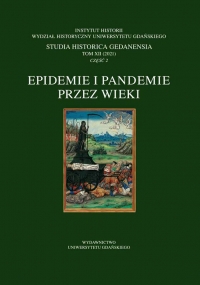Zadżumione miasto. Sztokholm wobec zarazy
w latach 1710–1711
Plague city. Stockholm and the plague of 1710
Author(s): Gabriela MajewskaSubject(s): History, Social history, Modern Age, 18th Century
Published by: Wydawnictwo Uniwersytetu Jagiellońskiego
Keywords: plague; prevention and treatment; Stockholm
Summary/Abstract: The epidemic of plague in Stockholm between 1710 and 1711 was part of a great pandemic that devastated Eastern, Central, and Northern Europe in the first decade of the century and, at the same time, was the greatest demographic catastrophe in the history of the Swedish capital, as a result of which around 40% of the city’s population died. The first cases of plague appeared at the start of 1710; the peak of infections and deaths was in the autumn (October and November); in winter, the disease lessened and the last cases occurred in February 1711. It is estimated that the number of deaths reached 22,000. The suburbs and the poorest districts suffered most. Scarcity and famine, which struck Sweden at the end of the first decade of the XVIIIth century, fostered the rapid spread of the disease in the city and the high rate of mortality. The plague was also fostered by the effects of the war conducted by Charles XII and, particularly, the defeats suffered by the Swedish army and the seizure of the Baltic provinces by Peter the Great, which led to migrations from already plague-infected regions and worsened the already poor sanitary conditions in the city. Refugees from Estonia probably brought the plague to Stockholm.The Swedish authorities undertook measures against any epidemic as early as 1708 after receiving information about the spread of plague on the northern shores of the Baltic. These were limited to monitoring the movement of population. In 1709, quarantine was introduced for arrivals. After the first cases of plague in Stockholm regulations concerning people’s movements were made more strict, epidemic services were set up, and sanitary and public order directives were issued. Announcement of the plague was delayed until mid-September, when the number of deaths rose hugely, and it was obvious that the authorities were not in a position to control the spread of the epidemic. The city was closed, an ordinance against plague was issued regulating especially issues connected with health certificates, travel restrictions, maintaining cleanliness in houses and on the streets, compulsory registration and isolation of the sick, organization of interments, and the use of disinfectants and medicines. The reaction of the Stockholm authorities to the appearance of plague in the city reflected the actions of other Baltic cities struggling with plague at the same time.
Journal: Studia Historica Gedanensia
- Issue Year: 2/2021
- Issue No: 12
- Page Range: 228-246
- Page Count: 19
- Language: Polish

